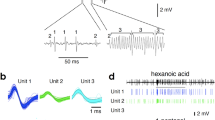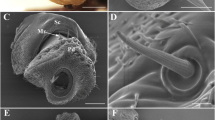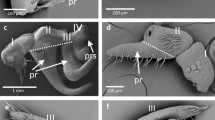Summary
-
1.
Three morphologically different types of sensilla are found on the surface of the funiculus of the blowflyCalliphora vicina (=C. erythrocephala). In the large antennal pits there is an identical population of grooved hairs, and in the small antennal pits only sensilla basiconica are observed. It was proved that sensilla of the large pits have an olfactory function; likewise, those of the small pits probably perform an olfactory function.
-
2.
Different receptors responded to the odour of decaying meat and volatile compounds of flowers; we can thus classify them receptors for meat-odour and flower-odour. Their reaction spectra were determined using pure compounds.
-
3.
Six different types of meat-odour receptors have been identified. They respond with different states of excitation to the meat-odours, enabling the fly to detect to what degree the meat is decayed. Three types of flower-odour receptors are known, which respond to stimulation by different volatile flower compounds.
-
4.
The hexanol receptors (one type of meat-odour receptor) react well to compounds with a chain-length between 5 and 7 C-atoms (maximum 6 C-atoms) and either an alcohol, aldehyde, or keto group.
-
5.
The position of single functional groups is not important; however, the effectiveness of compounds with two functional groups (e.g. carbonyl group and double bond) increases with the distance between the functional groups.
-
6.
None of the odoriforous compounds tested that were effective on the hexanol receptors are identical with the effective fraction from the meat-odor.
Zusammenfassung
Drei morphologisch unterschiedliche Sensillentypen treten auf der Funiculusoberfläche der SchmeißfliegeCalliphora vicina (=C. erythrocephala) auf, in den großen Antennengruben ausschließlich identische Rillenhaare und in den kleinen Gruben ausschließlich Sensilla basiconica. Eine olfaktorische Funktion ist fÜr die Sensillen der großen Gruben nachgewiesen, fÜr die der kleinen Gruben wahrscheinlich gemacht.
-
2.
Mehrere Reaktionstypen reagieren auf den Geruch von faulem Fleisch oder auf flÜchtige Blumeninhaltsstoffe. Sie lassen sich zu zwei Rezeptorgruppen, den Fleischduftrezeptoren und den Blumenduftrezeptoren zusammenfassen. Ihre Geruchsspektren werden durch Reizung mit reinen Substanzen bestimmt.
-
3.
Sechs Typen von Fleischduftrezeptoren werden beschrieben, die den Duft verschieden alter Fleischproben mit unterschiedlicher Erregung beantworten und das Erkennen des Fäulnisgrades des Fleisches ermöglichen. Ferner können vorerst drei Typen von Blumenduftrezeptoren unterschieden werden, die eine Reizung mit flÜchtigen Blumeninhaltsstoffen mit Erregung beantworten.
-
4.
Der Hexanoltyp, einer der Fleischduftrezeptoren, wird von Verbindungen mit einer Kettenlänge von 5–7 Kohlenstoffatomen (Maximum bei C-6) erregt, die eine Alkohol-Aldehyd-oder Ketogruppe enthalten.
-
5.
Liegt nur eine funktioneile Gruppe vor, so ist deren Stellung nicht von Bedeutung. Bei zwei funktionellen Gruppen (z.B. Carbonylgruppe und Doppelbindung) wird die Verbindung umso wirksamer, je weiter sie voneinander entfernt stehen.
-
6.
Keine der erregenden Substanzen kommt fÜr den Hexanoltyp als wirksamste Fraktion des Fleischgeruches in Betracht.
Similar content being viewed by others
Literatur
Beets, M. G. J.: Olfactory response and molecular structure. In: Handbook of sensory physiology, vol. IV: Chemical senses (ed. L.M. Beidler), p. 257–321. Berlin-Heidelberg-New York: Springer 1971
Boeckh, J.: Elektrophysiologische Untersuchungen an einzelnen Geruchsrezeptoren auf den Antennen des Totengräbers. Z. vergl. Physiol.46, 212–248 (1962)
Boeckh, J.: Reaktionsschwelle, Arbeitsbereich und Spezifität eines Geruohsrezeptors auf der Heuschreckenantenne. Z. vergl. Physiol.55, 378–406 (1967a)
Boeckh, J.: Inhibition and excitation of single insect olfactory receptors, and their role as a primary sensory code. In: II. Int. Symp. Olfaction and Taste (ed. T. Hayashi), p. 721–735. Oxford: Pergamon Press 1967b
Boeckh, J.: Electrical activity in olfactory receptor cells. In: III. Int. Symp. Olfaction and Taste (ed. C. Pfaffmann), p. 34–51. New York: Rockefeller University Press 1969
Cross, C. K., Ziegler, P.: A comparison of the volatile fractions from cured and uncured meat. J. Food Sci.30, 610–614 (1965)
Davies, J. T.: Olfactory theories. In: Handbook of sensory physiology, vol. IV: Chemical senses (ed. L.M. Beidler), p. 322–350. Berlin-Heidelberg-New York: Springer 1971
Dumpert, K.: Alarmstoffrezeptoren auf der Antenne vonLasius fuligunosus (Latr.) (Hymenoptera, Formicidae). Z. vergl. Physiol.76, 403–425 (1972)
Grosch, W.: Der oxidative Fettverderb. Chemie in unserer Zeit4, 121–126 (1970)
Herz, K.O., Chang, S.S.: Meat flavor. Advances in Food Res.18, 1–83 (1970)
Hornstein, I., Crowe, P.F.: Flavor studies on beef and pork. J. agr. Food Chem.8, 494–498 (1960)
Kafka, W.A.: Molekulare Wechselwirkung bei der Erregung einzelner Riechzellen. Z. vergl. Physiol.70, 105–143 (1970)
Kaissling, K.E.: Insect olfaction. In: Handbook of sensory physiology, vol. IV: Chemical senses (ed. L.M. Beidler), p. 351–431. Berlin-Heidelberg-New York: Springer 1971
Kirchner, O.v.: Blumen und Insekten. Leipzig: Teubner 1911
Liebermann, A.: Correlation zwischen den antennalen Geruchsorganen und der Biologie der Musciden. Z. Morph. ökol. Tiere5, 1–97 (1925)
Zur Schmeißfliegenbekämpfung — Untersuchungen mit Lockstoffen. 14. Verh. dtsch. Ges. angew. Entomol. 43–45 (1957)
Sass, H.: Das komplexe Zusammenspiel mehrerer Rezeptoren bei der nervösen Codierung von FuttergerÜchen. Verh. dtsch. Zool. Ges. Mainz66, 198–201 (1972)
Steinbrecht, R. A.: Der Feinbau olfaktorischer Sensillen des Seidenspinners (Insecta, Lepidoptera). Z. Zellforsch.139, 533–565 (1973)
Vareschi, E.: Duftunterscheidung bei der Honigbiene, Einzelableitungen und Verhaltensreaktionen. Z. vergl. Physiol.75, 143–173 (1971)
Waldow, U.: Elektrophysiologie eines neuen Aasgeruchrezeptors und seine Bedeutung fÜr das Verhalten des Totengräbers (Necrophorus). J. comp. Physiol.83, 415–424 (1973)
Wilson, R. A., Katz, I.: Review of literature on chicken flavor and report of isolation of several new chicken components from aqueous cooked chicken broth. J. agr. Food Chem.20, 741–747 (1972a)
Wilson, R.A., Katz, I.: Review of literature on chicken flavor and report of isolation of several new chicken components from aqueous cooked chicken broth. J. agr. Food Chem.20, 747–751 (1972b)
Author information
Authors and Affiliations
Additional information
Dissertation der Naturwissenschaftlichen Fakultät der Universität Regensburg. Mit UnterstÜtzung der Deutschen Forschungsgemeinschaft (Bo 343/2).
Rights and permissions
About this article
Cite this article
Kaib, M. Die Fleisch- und Blumenduftrezeptoren auf der Antenne der SchmeißfliegeCalliphora vicina . J. Comp. Physiol. 95, 105–121 (1974). https://doi.org/10.1007/BF00610109
Received:
Issue Date:
DOI: https://doi.org/10.1007/BF00610109




